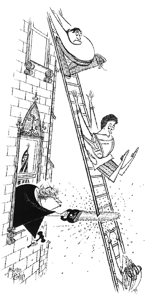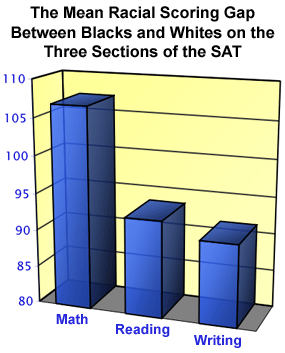University of North Carolina at Chapel Hill Posts Major Gain in Black First-Year Enrollments
 The University of North Carolina reports that 470 black freshmen enrolled on the Chapel Hill campus this fall. This is an increase of 13 percent over the 416 black freshmen who enrolled a year ago. Blacks make up 12.3 percent of the first-year class at Chapel Hill. This is the second-highest percentage of black first-year students at any of the nation’s 30 highest-ranked universities since JBHE first began its annual survey 13 years ago. Four years ago in 2002, blacks were 12.5 percent of the entering class at the Chapel Hill campus. The University of North Carolina reports that 470 black freshmen enrolled on the Chapel Hill campus this fall. This is an increase of 13 percent over the 416 black freshmen who enrolled a year ago. Blacks make up 12.3 percent of the first-year class at Chapel Hill. This is the second-highest percentage of black first-year students at any of the nation’s 30 highest-ranked universities since JBHE first began its annual survey 13 years ago. Four years ago in 2002, blacks were 12.5 percent of the entering class at the Chapel Hill campus.
Through the years, the University of North Carolina at Chapel Hill accepted a larger percentage of black applicants compared to the application pool as a whole. This year, 33 percent of black applicants were accepted compared to 34 percent of all applicants. The university saw a jump in black student yield from 51 percent to 57 percent, resulting in the near-record level of African-American first-year enrollments.
  |
“Harvard simply does not need early admissions to build a stable, high-quality student body. It could require that kids submit their applications in person with shaved heads, and still it would get a disproportionate share of America’s most talented students.”
— Arthur C. Brooks, professor of public affairs at Syracuse University, writing in The Wall Street Journal, September 14, 2006
|
The Center for Individual Rights Is a Persistent Thorn in the Side of African-American Higher Education
 The Center for Individual Rights has filed a federal lawsuit challenging a summer intern program for minority journalism students at Virginia Commonwealth University. The program is designed to increase the number of minority journalists and is not open to white students. The Center for Individual Rights has filed a federal lawsuit challenging a summer intern program for minority journalism students at Virginia Commonwealth University. The program is designed to increase the number of minority journalists and is not open to white students.
The summer intern program is operated by the university in conjunction with the Richmond Times-Dispatch and the Dow Jones Newspaper Fund. Similar programs are operated at about 20 colleges and universities nationwide.
The Center for Individual Rights has been a thorn in the side of black higher education since it was founded in 1989. CIR represented the plaintiff in the 1996 Hopwood case, which banned race-sensitive admissions in Texas. It later represented the plaintiffs in the two affirmative action cases at the University of Michigan. It has recently been active in securing a place on the November ballot for the Michigan Civil Rights Initiative, which, if enacted, would ban race-sensitive admissions at the University of Michigan.
Texas Is Considering a Moratorium on Its “10 Percent” Admissions Plan
 After the 1996 Hopwood ruling by the Fifth Circuit Court of Appeals outlawed race-sensitive admissions at public universities in Texas, in 1997 the state legislature passed a law in order to maintain some level of racial diversity at the University of Texas and other state-operated colleges and universities. The law granted automatic admission to the state university of their choice to students from the top 10 percent of every high school graduating class in the state. This enabled the top 10 percent of the graduating class in predominantly black inner-city high schools in Dallas and Houston and in rural areas of East Texas to qualify for admission to the state university of their choice. After the 1996 Hopwood ruling by the Fifth Circuit Court of Appeals outlawed race-sensitive admissions at public universities in Texas, in 1997 the state legislature passed a law in order to maintain some level of racial diversity at the University of Texas and other state-operated colleges and universities. The law granted automatic admission to the state university of their choice to students from the top 10 percent of every high school graduating class in the state. This enabled the top 10 percent of the graduating class in predominantly black inner-city high schools in Dallas and Houston and in rural areas of East Texas to qualify for admission to the state university of their choice.
Now, 71 percent of all students in the University of Texas system qualify for admission under the 10 percent rule. This makes it extremely difficult for state universities to accept well-qualified students who do not graduate in the top 10 percent of their class. Some legislators want to see a moratorium put in place for several years to determine if racial diversity can be maintained without the 10 percent rule. State universities can now consider race as a positive factor in the admissions process.
For College-Bound Blacks, the Demise of Affirmative Action May Come Too Soon
 A new study by The College Board estimates that there still will be a large racial gap in standardized test scores 22 years from now. This is important because in the 2003 Grutter Supreme Court ruling, Justice Sandra Day O’Connor suggested that within 25 years all racial preferences in college admissions should come to an end. A new study by The College Board estimates that there still will be a large racial gap in standardized test scores 22 years from now. This is important because in the 2003 Grutter Supreme Court ruling, Justice Sandra Day O’Connor suggested that within 25 years all racial preferences in college admissions should come to an end.
The new study, authored by researchers at the University of Virginia and Princeton University, finds that if historical trends are projected into the future, black family income will still trail far behind white family income by 2028. Family income has a direct correlation to students’ scores on the SAT and other standardized admissions tests.
The study concludes that if race-sensitive admissions are banned in 2028 or before, black enrollments at the nation’s most selective colleges and universities would drop by about one half.
The study is contained in a new book, College Access: Opportunity or Privilege? published this month by Holtzbrink Publishers. For ordering information click here.
Three Blacks, Including Two University Professors, Win MacArthur Genius Awards
Each year the Chicago-based MacArthur Foundation presents $500,000 awards to about two dozen scholars and artists. These so-called genius awards come with no strings attached, permitting the winners to pursue their work without worrying about paying their bills.
This year, of the 25 recipients, three blacks — all college graduates — won MacArthur grants. Two hold faculty posts at major American universities. Following are this year’s black MacArthur Award winners.
 Regina Carter is a jazz violinist. She received classical training at the New England Conservatory of Music before branching out into jazz. A graduate of Oakland University in Rochester, Michigan, she has recorded six albums and performed all over the world including Lincoln Center in New York City and the Kennedy Center in Washington. Regina Carter is a jazz violinist. She received classical training at the New England Conservatory of Music before branching out into jazz. A graduate of Oakland University in Rochester, Michigan, she has recorded six albums and performed all over the world including Lincoln Center in New York City and the Kennedy Center in Washington.
 John A. Rich is a professor of health management and policy at Drexel University in Philadelphia. He concentrates his research on the healthcare needs of young black men. A graduate of Dartmouth College, Dr. Rich received his medical training at Duke University School of Medicine. He also holds a master’s degree in public health from Harvard University. He previously held a faculty position at Boston University. John A. Rich is a professor of health management and policy at Drexel University in Philadelphia. He concentrates his research on the healthcare needs of young black men. A graduate of Dartmouth College, Dr. Rich received his medical training at Duke University School of Medicine. He also holds a master’s degree in public health from Harvard University. He previously held a faculty position at Boston University.
 Jennifer Richeson is an associate professor of psychology at Northwestern University. Her social psychology research centers on behavioral patterns of prejudice and racial stereotyping. Professor Richeson is a graduate of Brown University and holds a Ph.D. in social psychology from Harvard University. She has previously held faculty positions at Stanford University and Dartmouth College. Jennifer Richeson is an associate professor of psychology at Northwestern University. Her social psychology research centers on behavioral patterns of prejudice and racial stereotyping. Professor Richeson is a graduate of Brown University and holds a Ph.D. in social psychology from Harvard University. She has previously held faculty positions at Stanford University and Dartmouth College.

Wayne State University

Assistant Professor of American Literary and Cultural Studies Before 1865
The Department of English at Wayne State University invites applications for a tenure-track assistant professorship in American Literary and Cultural Studies before 1865. The Department is committed to scholarship and teaching that is both historically focused and theoretically grounded. For complete posting and to submit an online application, applicants must go to http://jobs.wayne.edu (posting 033409). On-line application, including CV and letter of application addressed to Richard Grusin, Chair, Department of English, must be submitted by November 3. Wayne State University is a premier institution of higher education offering more than 350 academic programs through 14 schools and colleges to more than 31,000 students in metropolitan Detroit. Wayne State University is an equal opportunity/
affirmative action employer. Minority candidates are especially encouraged to apply.
18th-Century Literary and
Cultural Studies-Rank Open
The Department of English at Wayne State University invites applications for an open-rank position in 18th-Century Literary and Cultural Studies. Preference will be given to candidates who are tenured or very near tenure, but serious consideration will be given to entry-level candidates as well. The Department is committed to scholarship and teaching that is both historically focused and theoretically grounded. For complete posting and to submit an online application, applicants must go to http://jobs.wayne.edu (posting 033408). On-line application, including CV and letter of application addressed to Richard Grusin, Chair, Department of English, must be submitted by November 3. Wayne State University is a premier institution of higher education offering more than 350 academic programs through 14 schools and colleges to more than 31,000 students in metropolitan Detroit. Wayne State University is an equal opportunity/affirmative action employer. Minority candidates are especially encouraged to apply.

The Racial Scoring Gap on the New SAT Writing Test
The 2006 high school senior class was the first group of students who took the new SAT which includes a third score measuring a student’s ability to communicate through writing. Many of the nation’s leading colleges are skeptical that the writing test is useful in predicting how well a student will perform in college. A great many of the nation’s highest-ranked colleges and universities do not even consider an applicant’s score on the writing test as a factor in the admissions process. Others give less weight to the writing score than they do to an applicant’s results on the reading and mathematical sections of the SAT.
Aside from how colleges use the results, readers may be interested in knowing how black students fared on the new writing section of the SAT. The mean black score on the writing section in 2006 was 428. For whites, the mean score was 519. Therefore, the 91-point gap on the writing portion of the SAT is slightly smaller than the gap on the reading portion of the SAT and significantly smaller than the racial gap on the mathematics section of the SAT.
The fact that blacks score lower on the writing portion of the test is not surprising. The College Board’s data on students who took the SAT show that 67 percent of whites had taken high school courses in composition compared to 52 percent of blacks. Some 71 percent of whites and 61 percent of blacks had completed coursework in grammar.
Many observers believe that by design the writing component of the SAT was introduced to lessen the racial scoring gap on the SAT in order to deflect criticism of The College Board that the test is racially biased. It is probable that in some instances the people who score the new writing section will be able to detect the race of the writer by the vocabulary and subject matter of the student’s essay. There is then a suspicion in some quarters that the scorers of the test may be inclined to ‘give a break’ to black students. Therefore, it is suggested that the examination is graded on a curve that benefits blacks and Hispanics.

Kenyan Scholar at University of New Mexico Arrested and Scheduled for Deportation
 Chao Sio, a Kenyan who taught Swahili in the African-American studies department at the University of New Mexico in Albuquerque, was arrested and is awaiting deportation to her native land. Sio, now 30 years old, came to the United States seven years ago on a student visa. When the visa expired she applied for political asylum. This request was denied. Chao Sio, a Kenyan who taught Swahili in the African-American studies department at the University of New Mexico in Albuquerque, was arrested and is awaiting deportation to her native land. Sio, now 30 years old, came to the United States seven years ago on a student visa. When the visa expired she applied for political asylum. This request was denied.
 Willie Ruff and Mitch Leigh
Willie Ruff and Mitch Leigh
Endowed Chair Established at Yale to Honor Jazz Great
The Yale School of Music announced the creation of the Willie Ruff Chair in Jazz. Ruff is currently a professor of music at the school and director of the Duke Ellington Scholarship Program.
The endowment for the chair was donated by Mitch Leigh, the Tony Award-winning composer of Man of La Mancha. Leigh and Ruff were former classmates at Yale.
Ominous Poll Results on Public Referendum That Would Ban Race-Sensitive Admissions at the University of Michigan
 We are just about one month from Election Day and a recent poll shows the Michigan Civil Rights Initiative gaining strength among likely voters. The initiative would ban the use of race in admissions decisions at state universities in Michigan. A poll by The Detroit News finds that 48 percent of respondents said they would vote to approve the measure compared to 37 percent who oppose it. We are just about one month from Election Day and a recent poll shows the Michigan Civil Rights Initiative gaining strength among likely voters. The initiative would ban the use of race in admissions decisions at state universities in Michigan. A poll by The Detroit News finds that 48 percent of respondents said they would vote to approve the measure compared to 37 percent who oppose it.
Many observers believe that the wording of the proposal will make it more appealing to uninformed voters. The initiative asks voters if they want to “outlaw preferential treatment to individuals or groups, on the basis of minority status or gender, in government and in college admissions.” Similar wording on Proposition 209 in California resulted in a higher “Yes” vote than earlier poll numbers had indicated.
Both sides plan major advertising campaigns prior to the election.

Texas Tech University

College of Architecture: Assistant Professor, Tenure-track Position - Architectural Design fall 2007.
College of Arts and Sciences
Biological Sciences: Tenure-track/Assistant Professor beginning September 2007.
Chemistry and Biochemistry: 2 Tenure-track/Assistant, Associate Professors-Materials chemistry or medicinal chemistry.
Economics and Geography: 2 Tenure-track/assistant professors-Macroeconomics.
English Requisition #72361: Tenure-track/Assistant Professor-English, Postcolonial Literature.
History: 2 Tenure-track/Assistant Professors U.S. West/Southwest. Tenure-track/Assistant Professor North American Atlantic World. Tenure track/Assistant Professor Region of the Muslim World.
Political Science: Tenure-track/Assistant Professor, Judicial Behavior/Politics fall 2007. Tenure-track/Assistant Professor, American Political Institutions. Tenure-track/Assistant Professor, Political Behavior, American political behavior fall 2007. Tenure-track/Assistant Professor, Political Behavior/Director Earl Survey Research Center fall 2007. Tenure-track/Assistant Professor, International Relations August 2007. Tenure-track/Assistant Professor, Master of Public Administration program fall 2007. Tenure track/assistant professor Master of Public Administration program fall, 2007.
College of Education
Educational Leadership: 2 full-time, tenure track positions, open rank.
Higher Education: 2 full-time, tenure track positions.
Educational Psychology: Assistant/Associate Professor, Educational Research, Statistics, and Measurement.
Instructional Technology: Full-time, tenure track assistant or associate professor position.
College of Engineering
Chemical Engineering Requisition #62249: Tenure-track/Assistant or Associate Professor.
Electrical and Computer Engineering: Chairperson and Professor of the Department of Electrical and Computer Engineering Summer or fall 2007. Tenure-track/assistant or associate professor Bioengineering . Endowed Keh-Shew Lu Regents Chair/associate/full professor level.
Industrial Engineering Requisition #74250: Tenure eligible Assistant Professor. Requisition # 72451: Bryan Pearce Bagley Regents Chair. Requisition # 72452: E.L. Jr. and Sue Derr Professorship Ergonomics.
Petroleum Engineering: Assistant/Associate/Full Professor.
College of Human Sciences
Family Studies Requisition #72423: Tenure-track full-time Assistant/Associate professor.
Child Development/Early Childhood Requisition # 72428: Tenure-track Assistant/Associate professor, August 2007.
Hotel and Institutional Management 2005TLF090: Tenure-track or tenured associate/professor James C. and Kailee Professorship.
College of Mass Communications
Electronic Media & Communications Requisition # 61118: Tenured or tenure track/Assistant or Associate professor.
Electronic Media & Communications Requisition #61900: Assistant Professor/Associate Professor.
College of Visual and Performing
School of Art Requisition #2007 TLF 076: Tenured Associate Professor or Professor/Director, commensurate with qualifications and experience fall 2007.
School of Law: Tenure-track position and 405(c) status lawyering skills contract position 07-08.

|
Contrary to Reports in the Press, There Is No Surge in Hispanic Enrollments at the Black Colleges
 This past August the Associated Press distributed a story headlined, “Black Colleges Diversifying by Recruiting More Hispanics.” The article stated that because black colleges are facing increased competition from predominantly white institutions, they in turn are looking to expand their enrollment base by recruiting more Hispanic students. This past August the Associated Press distributed a story headlined, “Black Colleges Diversifying by Recruiting More Hispanics.” The article stated that because black colleges are facing increased competition from predominantly white institutions, they in turn are looking to expand their enrollment base by recruiting more Hispanic students.
The article gave the impression that the push by black colleges for Hispanic students is a widespread phenomenon.
But a JBHE analysis of new data from the U.S. Department of Education shows that very few Hispanic students are choosing to enroll at black colleges and universities. In fact, Hispanics make up more than 5 percent of the total enrollment at only three black colleges. All of these colleges are located in areas with large Hispanic populations.
In contrast, at all but nine black colleges, Hispanics are less than 2 percent of all students. At a majority of the nation’s black colleges, Hispanics are less than one half of one percent of the student body. Seven black colleges and universities report no Hispanic students whatsoever.
The Most Racially Diverse Liberal Arts Colleges
 According to the new U.S. News & World Report rankings, Pine Manor College in Chestnut Hill, Massachusetts, is the most racially diverse liberal arts college in the nation. Current Department of Education data shows that African Americans are the largest minority group on this all-women campus, making up 42 percent of the student body. Hispanics are 12 percent of the student body and Asians are 5 percent of all students. Whites make up 23 percent of the total. More than 16 percent of the students are foreign or their race/ethnicity is not known. According to the new U.S. News & World Report rankings, Pine Manor College in Chestnut Hill, Massachusetts, is the most racially diverse liberal arts college in the nation. Current Department of Education data shows that African Americans are the largest minority group on this all-women campus, making up 42 percent of the student body. Hispanics are 12 percent of the student body and Asians are 5 percent of all students. Whites make up 23 percent of the total. More than 16 percent of the students are foreign or their race/ethnicity is not known.
Other liberal arts colleges rated as among the most racially diverse where African Americans are the largest minority group are Rosemont College in Pennsylvania, Wesleyan College in Georgia, Marymount Manhattan College in New York City, and Mills College in California.

Washington State University

President
After seven years of distinguished service, President V. Lane Rawlins will retire in June 2007. The Board of Regents invites nominations and applications for the position of President.
The University: Washington State University is a top-tier doctoral research university that conducts influential research and provides world-class education to a diverse student population of more than 23,000 students statewide. Founded in Pullman in 1890, WSU today is co-located in Pullman and Spokane with regional campuses in the Tri-Cities (Richland, Pasco and Kennewick) and in Vancouver, across the Columbia River from Portland, Oregon. Regional Learning Centers and the Distance Degree Programs offer access to WSU degrees across Washington and around the globe. WSU is Washington’s land-grant university.
Students choose from more than 250 fields of study and learn in a challenging, hands-on environment. The colleges and schools are the College of Agricultural, Human, and Natural Resource Sciences; College of Business; College of Education; College of Engineering and Architecture; College of Liberal Arts; Intercollegiate College of Nursing; College of Pharmacy; College of Sciences; College of Veterinary Medicine; the Graduate School; and the University Honors College.
The Position: The Committee seeks a visionary leader with a strong commitment to excellence in higher education, demonstrated administrative skills in managing a complex organization, and the ability to guide the institution to greater national prominence as a research university. Leading candidates will possess a terminal degree and a strong understanding of, and appreciation for, excellent teaching, scholarship, and service. An appreciation for the role of the University as a partner in enhancing economic development in the region, and the capacity to attract financial support from the public and private sectors are essential. Excellent communication skills are of vital importance as the President is the chief representative of the University to a wide array of external constituencies.
The Search: The committee is being assisted in the search by Greenwood & Associates, Inc. For fullest consideration, application materials must be received prior to November 3, 2006. Review of applications will begin immediately and will continue until an appointment is made. Application materials should include a letter addressing how the candidate’s experience matches the position requirements and a curriculum vitae, together with the names, titles, and contact information for at least five references. Submission of materials as an MS Word attachment is strongly encouraged. Individuals wishing to place names in nomination should submit a letter of nomination which includes the name, position, address and telephone number of the nominee. Requests for information, written nominations, and application materials should be directed to:
Greenwood & Associates, Inc
Dr. Jan Greenwood or Dr. Betty Turner Asher
Washington State University President Search
42 Business Center Drive, Suite 307
Miramar Beach, FL 32550
Phone: 850 269-7450
Fax: 850 650-2272
Email: jangreenwood@greenwoodsearch.com
bettyasher@greenwoodsearch.com
Washington State University is an affirmative action, equal opportunity employer.
For more information about WSU please visit our Web site www.wsu.edu

At the Black Colleges, Faculty Salaries Are Lower But There Is Greater Gender Equity in Pay
Women’s pay in the academic world and in the workplace as a whole is generally lower than the pay given to men. Overall, women faculty members of all races earn about 80 percent of male faculty members.
 A new study by researchers at the University of Georgia, published in the scholarly journal Gender & Society, examines the gender and racial differences in faculty pay between historically black and predominantly white colleges and universities during the 2001-02 academic year. The research shows that, as expected, both men and women employed at HBCUs earn less than their counterparts at predominantly white colleges and universities. But the pay gap between men and women at predominantly white colleges and universities is double the gender pay gap that exists at the black colleges and universities. The authors suggest that black male academics are becoming a rare commodity in the academic world and, therefore, there is a great deal of competition for their services at predominantly white universities. This in turn leads to higher salaries for black men at predominantly white colleges and universities. A new study by researchers at the University of Georgia, published in the scholarly journal Gender & Society, examines the gender and racial differences in faculty pay between historically black and predominantly white colleges and universities during the 2001-02 academic year. The research shows that, as expected, both men and women employed at HBCUs earn less than their counterparts at predominantly white colleges and universities. But the pay gap between men and women at predominantly white colleges and universities is double the gender pay gap that exists at the black colleges and universities. The authors suggest that black male academics are becoming a rare commodity in the academic world and, therefore, there is a great deal of competition for their services at predominantly white universities. This in turn leads to higher salaries for black men at predominantly white colleges and universities.
At Last, the University of Chicago Is Making a Concerted Effort to Recruit Black Students
 The University of Chicago has a rich history in providing educational opportunities for African Americans at the graduate level. But in recent years, black undergraduate enrollments at the University of Chicago have usually lagged those of the university’s peer institutions by a large margin. The University of Chicago has a rich history in providing educational opportunities for African Americans at the graduate level. But in recent years, black undergraduate enrollments at the University of Chicago have usually lagged those of the university’s peer institutions by a large margin.
However, this fall there are 81 black freshmen at the University of Chicago. This is an increase of more than 52 percent from a year ago. This year, blacks are 6.4 percent of the entering class, up from 4.9 percent a year ago.
Dean of Admissions Ted O’Neill told JBHE that “for the first time, we hosted an overnight for black students in the fall. Not only did we have the chance to spend time with the overnight visitors, but our own students became more involved with the recruitment effort.”
Dean O’Neill also noted that the new Collegiate Scholars program at Chicago’s public schools is now producing qualified recruits. The program includes 60 students who complete a three-year academic preparation course during the school year and over summers. Collegiate Scholars are eligible for five full-tuition scholarships that the University of Chicago gives out each year to graduates of this program.
  |
2,165,000 Total black enrollments in higher education in 2004.
2,755,000 Estimated total enrollments of blacks in higher education in 2015.
source: U.S. Department of Education
|
 Black Enterprise’s Flawed College Rating Formula Black Enterprise’s Flawed College Rating Formula
Florida A&M University in Tallahassee is rated as the best college for African Americans in the latest Black Enterprise survey.
To be sure, Florida A&M has provided a college education to tens of thousands of young blacks. The institution has many strengths. But does it really deserve Black Enterprise’s endorsement as the best college in the nation for African-American students? Consider the following:
- The black student graduation rate at Florida A&M University is 34 percent.
- Student hazing has been a major problem on campus.
- Enrollments have fallen in each of the past two years.
- The university’s law school has the lowest bar passage rate in the state.
- In February 2006 the National Collegiate Athletic Association placed Florida A&M University on probation for four years. More than 30 athletic scholarships were taken away from the university when the NCAA discovered 200 violations in 15 intercollegiate sports.
- 41 people were fired from the university after a payroll audit found that they did no work at the university.
- In 2005 the Orlando Sentinel said that it appeared that Florida A&M had been taken over by the “Marx Brothers Management Corp.”
- In 2005 the National Science Foundation announced that it would discontinue funding its grants to the institution until it was assured that the money would not be wasted.
- In 2005 an internal audit showed a $23 million gap in budget allocations and spending, and administrators were unable to determine why the budget gap occurred.
With all the troubles besetting Florida A&M, it seems highly unlikely that the school is the best place for a young African-American student. Are the life chances of a young African American better off with a diploma from Florida A&M, or one from MIT or Vanderbilt? These two universities have shown a strong commitment to racial diversity and have high black student graduation rates, but neither made the Black Enterprise Top 50 list.
Hampton University Agrees to Return Statue to Kenyan Family
Kigango statues are wooden posts with a round head carved at the top. Hampton University in Virginia has 99 kigango statues in its collection. This is considered the largest collection in the United States. Now it is sending one of its statues back to Kenya.

1985 photographic evidence produced by Monica Udvardy that the kigango statues belonged to the Mwakiru family of Kenya
In 1983 Kalume Mwakiru commissioned two kigango statues to honor his dead brothers. The statues were stolen from the front of his home in 1985. In 1999 anthropologist Monica Udvardy traced the two missing statues to museums at Illinois State University and Hampton University. Both universities acquired the statues legally as a gift from a benefactor who had bought them from a reputable gallery.
This past winter Illinois State University agreed to return its statue to the Mwakiru family. In late September a Kenyan delegation went to Illinois and was presented with the statue. The delegation hoped to get the second statue at Hampton University but the historically black college originally declined the request. The university said that it had acquired the statue legally and would not return it unless there was indisputable evidence that it had been stolen. Hampton admits that the statue once belonged to the Mwakiru family but says that it has not been presented with proof that the statue was stolen.
After press reports surfaced that Hampton was refusing to return the statue to Kenya, the university decided that it would “loan” the statue from its collection to the Mwakiru family on an “indefinite basis.” The university’s position is that it remains the rightful owner until such time as there is “proof beyond a reasonable doubt that the statue was illegally acquired.”

Interdenominational Theological Center

Womanist Scholars Fellowship
The Womanist Scholars Program, a component of the Black Women in Church and Society Program (Jacquelyn Grant, PhD, Director) at the Interdenominational Theological Center in Atlanta, Georgia, provides affirming, creative and intellectual opportunities for womanist scholars to engage in scholarship. This appointment is given annually to two Visiting Scholars who have done significant research on issues concerning Black women, religion and spirituality. The Womanist Scholars Program is designed to assist Black women scholars seeking sabbatical or independent support for a specific research project. Requirements include one academic year in residence along with teaching (one course), (one public) lecture, research and writing for publication. It awards a $37,500 fellowship.
Applicants must submit: a completed application form; research prospectus (not to exceed four typed pages) outlining the intended research project with the proposed methodology and the project’s significance for the academic, religious and larger communities; one page narrative describing your philosophy of and commitment to womanist scholarship; a course proposal; writing sample (published or unpublished); current curriculum vitae and three letters of reference.
For information, contact Marion R. Pierre, Program Administrator, ITC-BWCS, 700 Martin Luther King, Jr. Dr. SW, Atlanta, Georgia 30314. Call 404-527-5713 or email mpierre@itc.edu, www.itc.edu/pages/wsp/WSPHome.htm.
The application and all supporting materials must be postmarked by December 8, 2006.

Appointments
 • Alfonso Scandrett Jr. is the new director of athletics at Lincoln University in Pennsylvania. He was the athletics director at Moorhead State University in Minnesota. He is a graduate of the University of Buffalo and holds a master’s degree in health education from Minnesota State University at Mankato and a Ph.D. from the University of Oregon in health sciences and epidemiology. • Alfonso Scandrett Jr. is the new director of athletics at Lincoln University in Pennsylvania. He was the athletics director at Moorhead State University in Minnesota. He is a graduate of the University of Buffalo and holds a master’s degree in health education from Minnesota State University at Mankato and a Ph.D. from the University of Oregon in health sciences and epidemiology.
• Jimmy Arrington was named assistant vice chancellor for student affairs and enrollment services at Winston-Salem State University in North Carolina. He was the assistant vice president for enrollment management at Delaware State University. Arrington holds bachelor’s and master’s degrees from Tuskegee University.
 • Darren Hamilton was named director of athletics at Eastern Washington University in Cheney, Washington. He was the athletic director at Chicago State University. He is the first African American to hold the position at EWU and only the second black athletic director in the Big Sky Conference. • Darren Hamilton was named director of athletics at Eastern Washington University in Cheney, Washington. He was the athletic director at Chicago State University. He is the first African American to hold the position at EWU and only the second black athletic director in the Big Sky Conference.
Hamilton is a graduate of Pennsylvania State University where he played on the 1982 national championship football team. He went on to earn a master’s degree in exercise and sports science and a Ph.D. in black history and sociology of sport at Penn State.
 Award Award
• John Thompson III, the head coach of the men’s basketball team at Georgetown University, received the Fritz Pollard Award from the Black Coaches Association as the 2006 coach of the year. The award is cosponsored by Brown University, where Pollard starred as a running back in football in the early 1900s. He later became the first African American to play in the National Football League.
Grant
• Five historically black colleges and universities in Tennessee will share a $2 million grant from the Tennessee Office of Minority Health to establish a wellness program for low-income state residents. The program will focus on health problems where there are wide-ranging racial disparities such as diabetes, hypertension, and kidney disease.
The grant will be under the direction of Meharry Medical College. Other participating institutions are Fisk University, Lane College, Knoxville College, and LeMoyne-Owen College.
|
 .
.